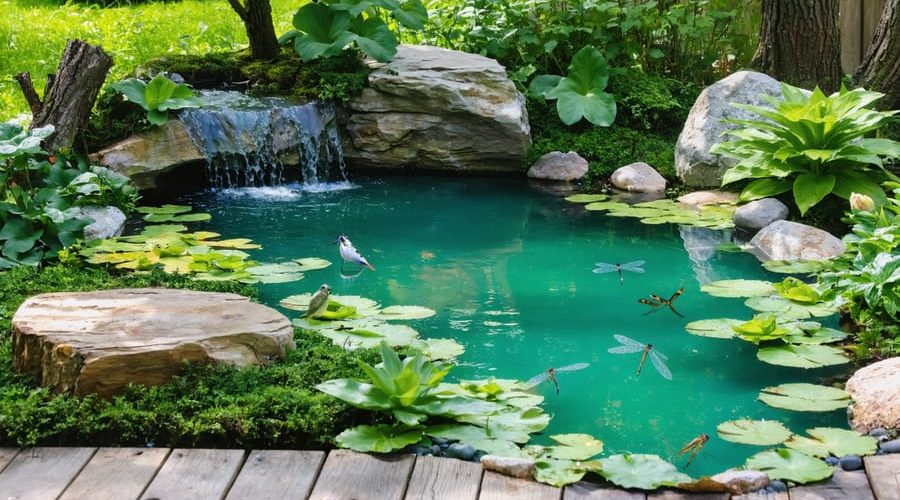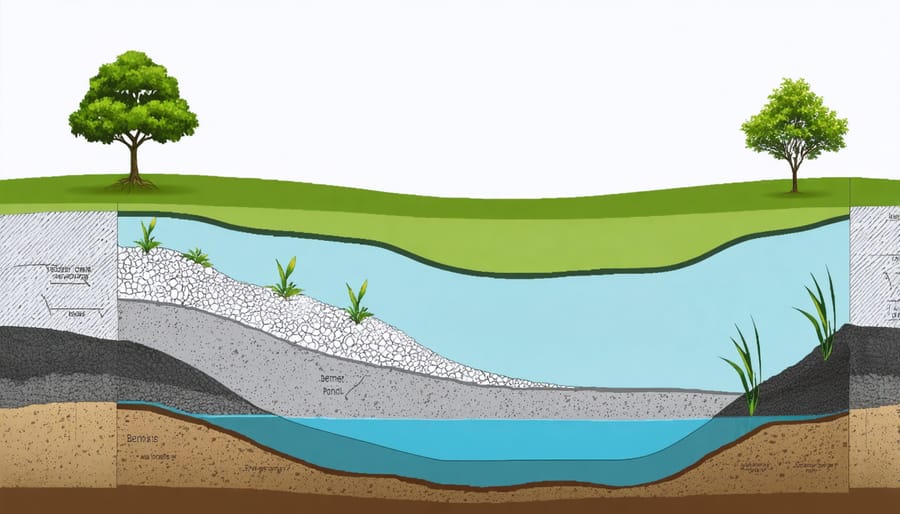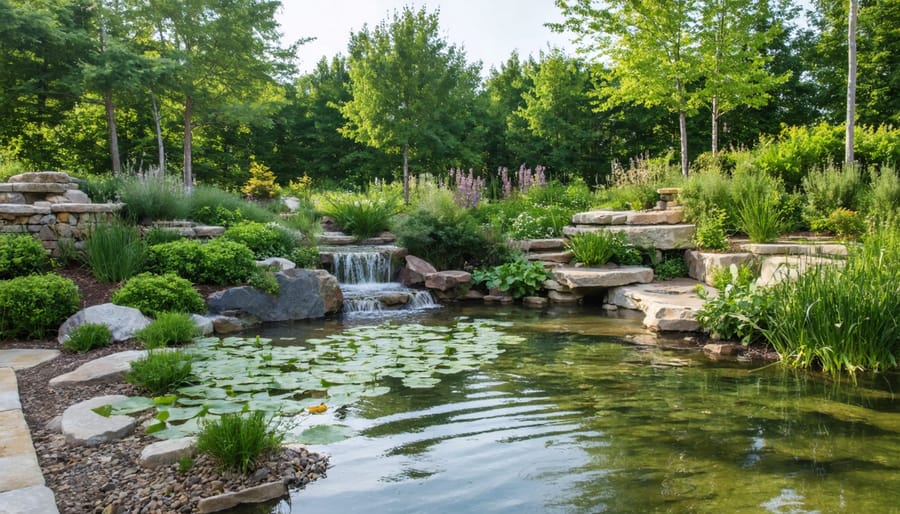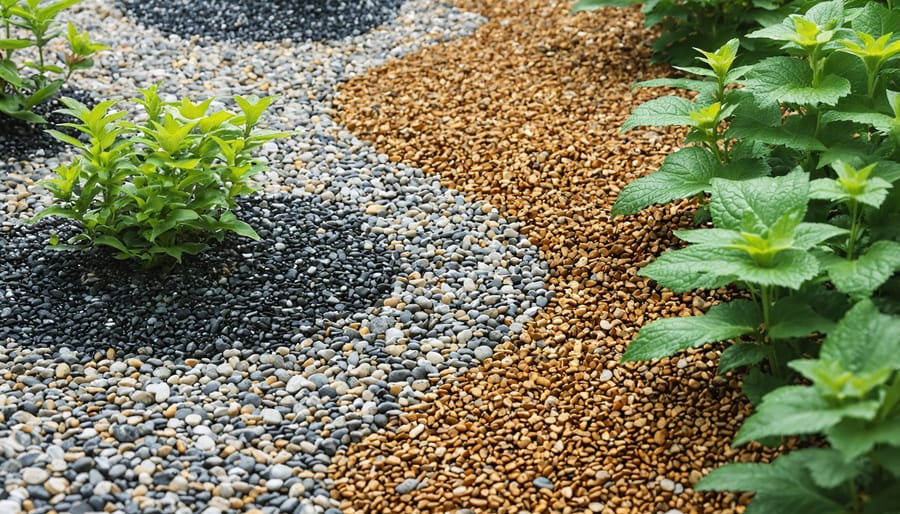
Build a Wildlife Pond That Lasts: Your Earth-Friendly Materials Guide
Transform your backyard into a thriving ecosystem by building your dream natural pond using sustainable materials and wildlife-friendly design principles. Start with a gently sloping profile featuring multiple depth zones – shallow margins (15cm) for amphibians, a mid-depth shelf (45cm) for aquatic plants, and a deep central area (75-90cm) providing crucial winter refuge for pond life. Choose recycled pond liners or pre-formed options made from recycled materials, avoiding traditional concrete that can alter water chemistry. Create natural hiding spots using locally sourced rocks and fallen branches, positioning them to form corridors that allow wildlife safe passage between different pond zones. The magic of a wildlife pond lies in its ability to attract native species naturally – from darting dragonflies to chorus frogs – while requiring minimal maintenance once established. Unlike ornamental ponds, these self-sustaining ecosystems work with nature, not against it, bringing the soothing sound of water and fascinating wildlife encounters right to your doorstep.
Natural Liners vs. Synthetic Options
Clay-Based Solutions
Clay-based solutions offer a fantastic natural approach to waterproofing your wildlife pond, with two main options to consider: bentonite clay and natural clay liners. Bentonite clay is a remarkable material that expands when wet, creating an incredibly effective seal. When mixed with soil or applied as a blanket liner, it forms a waterproof barrier that feels more natural than synthetic alternatives.
For smaller ponds, you can mix bentonite clay powder directly into your soil at a ratio of about 4-6 pounds per square foot. Spread the mixture evenly and compact it well to create a reliable seal. Pre-made bentonite clay liners are also available, offering a more straightforward installation process – simply lay them down and overlap the edges by about 6 inches.
Natural clay, if available in your area, provides an even more cost-effective solution. You’ll need a layer about 6-8 inches thick of good-quality clay soil. The key is proper compaction – work the clay in layers, dampening each layer slightly before compacting. Keep in mind that natural clay can be challenging to source and requires more labor to install correctly.
Both options create pond edges that wildlife can easily access and allow plants to root naturally. While these methods might take more initial effort than synthetic liners, they create more sustainable, natural-looking results that improve with age.

Eco-Friendly Synthetic Liners
For environmentally conscious pond builders, there’s a growing range of eco-friendly synthetic liner options that minimize environmental impact while maintaining durability. Recycled HDPE liners are becoming increasingly popular, made from repurposed plastic materials that would otherwise end up in landfills. These liners are just as reliable as traditional options but come with a significantly smaller carbon footprint.
Biodegradable pond liners, typically made from natural rubber compounds or plant-based materials, offer another sustainable choice. While they may have a shorter lifespan (usually 15-20 years) compared to traditional synthetic liners, they break down naturally without leaving harmful residues in the soil. Some innovative manufacturers are now producing hybrid liners that combine recycled materials with biodegradable components, offering the best of both worlds.
When selecting an eco-friendly liner, look for certifications from recognized environmental organizations and check the manufacturer’s sustainability practices. Many sustainable liners now come with UV protection and root resistance properties, making them practical choices for wildlife ponds. While these environmentally conscious options might cost slightly more upfront, they often prove cost-effective in the long run due to their durability and reduced environmental impact.
Remember to consider the full lifecycle of your pond liner – from production to eventual disposal. Some manufacturers even offer take-back programs for their products, ensuring proper recycling when the liner eventually needs replacement.
Sustainable Edge Materials

Local Stone and Rock Options
Using local stone and rock materials not only creates a natural-looking pond but also reduces environmental impact and transportation costs. When planning your backyard pond design ideas, start by exploring what’s available in your area. Local quarries often offer a variety of stones at reasonable prices, and some might even deliver to your site.
Look for rounded river rocks, which are perfect for creating shallow shelves and natural-looking edges. These smooth stones are safer for wildlife and easier to work with than sharp-edged rocks. If you’re lucky, you might find suitable stones during local construction projects or from farmers clearing their fields – just be sure to ask permission first!
For the pond’s edge, mix different sizes of stone, from large boulders to smaller pebbles. This creates a more natural appearance and provides various hiding spots for wildlife. Local slate or sandstone can work wonderfully for creating flat areas around the pond’s perimeter.
Before collecting any materials, check local regulations about removing stones from natural areas. Many regions have restrictions to protect the environment. When sourcing from suppliers, ask about the stone’s origin and whether it’s been treated with any chemicals that could affect pond life.
Remember to clean all stones thoroughly before use, removing any soil or debris that might affect water quality. Avoid limestone if possible, as it can alter your pond’s pH levels.
Reclaimed Materials
Creating a wildlife pond doesn’t mean you need to buy everything new. In fact, using reclaimed materials for your pond edges adds character while being environmentally friendly and budget-conscious. Old bricks, stones, and pavers from demolished patios or walls make excellent edging materials, providing natural-looking borders that blend seamlessly with the landscape.
Fallen logs and large branches can be partially submerged to create perfect basking spots for amphibians and attractive perches for birds. Just make sure any wood you use is untreated to avoid chemical leaching. Broken concrete slabs, often called “urbanite,” can be arranged to create interesting terraced edges and hiding spots for wildlife.
Local construction sites or home renovation projects can be goldmines for suitable materials – just remember to ask permission before taking anything. Garden centers sometimes give away or sell damaged paving stones at reduced prices, which work perfectly for pond edges. Old ceramic pots can be broken and arranged artistically around the edges, creating mini habitats for insects and small creatures.
When using reclaimed materials, clean them thoroughly and avoid anything that might have been treated with chemicals or paint. Natural weathering of materials often adds to their charm and helps them blend better with the surrounding environment. Remember to position heavier items on stable ground to prevent them from sliding into the pond over time.
Natural Filtration Systems

Plant-Based Filters
Natural filtration is one of the most effective and eco-friendly ways to maintain crystal-clear pond water. When it comes to small water garden filtration, plants are your best allies. Native aquatic plants not only look beautiful but also work tirelessly to keep your wildlife pond healthy and balanced.
Marginal plants like rushes and irises are excellent at removing excess nutrients from the water. Plant these along the pond’s edges where they can trap sediment and filter water as it enters the pond. Water lilies provide shade, reducing algae growth while offering shelter for pond creatures.
Submerged oxygenating plants like hornwort and water milfoil are particularly effective at absorbing nitrates and phosphates, which helps prevent algae blooms. Aim to cover about 50-60% of your pond’s surface with these natural filters.
For the best results, create different planting zones at varying depths. Deep-water plants should occupy the bottom, while floating plants like duckweed can cover portions of the surface. Remember to choose native species whenever possible, as they’re already adapted to your local climate and won’t become invasive.
Start with a few plants and gradually add more as needed. This gives your pond time to establish its natural balance while allowing you to observe which species thrive in your specific conditions.
Gravel and Stone Filters
Gravel and stone filters play a crucial role in maintaining the health of your wildlife pond by creating natural biological filtration zones. These areas act like nature’s own cleaning system, hosting beneficial bacteria that break down waste and help keep your pond water crystal clear.
Start by creating a shallow shelf around the pond’s edge or in designated areas, about 6-8 inches deep. Layer different sizes of stone and gravel, beginning with larger rocks (2-3 inches) at the bottom and gradually moving to smaller gravel (1/2 inch) at the top. This graduated approach prevents the materials from mixing while maximizing surface area for beneficial bacteria to colonize.
For best results, incorporate filter zones that water must pass through before entering the main pond. A popular method is to create a gravel-filled stream or cascade that feeds into your pond. This not only provides excellent filtration but also adds a beautiful, natural-looking water feature to your garden.
When choosing materials, opt for rounded river stones and gravel rather than crushed rock, as these are gentler on plant roots and visiting wildlife. Avoid limestone or other rocks that might affect your water’s pH. Aim to make your filter zones about 20% of your total pond surface area for optimal effectiveness.
Remember to occasionally clean these areas by gently stirring the gravel to prevent excessive buildup of debris, but don’t overdo it – you want to maintain the beneficial bacterial colonies that make your filter system work.
Material Sourcing Tips
Finding the right materials for your wildlife pond doesn’t have to be expensive or complicated. In fact, many sustainable options are available right in your local area. Start by checking local garden centers and landscape suppliers, as they often stock pond liners, plants, and other essential materials while offering valuable advice based on local conditions.
For the pond liner, consider EPDM rubber or ethically sourced butyl rubber, which are both durable and environmentally friendly options. While these might cost more initially, they typically last 20+ years and are worth the investment. Look for suppliers who offer remnants or off-cuts at reduced prices – these are perfect for smaller ponds and equally effective.
Natural stones and rocks can often be sourced from local quarries or reclamation yards. This not only reduces transportation costs and carbon footprint but also ensures your pond matches the local landscape. Many quarries offer mixed loads of different-sized stones, which is perfect for creating varied habitats around your pond.
Don’t overlook the possibility of repurposing materials. Local construction sites (with permission) or garden clearance projects can be excellent sources for rocks and slate. Community groups and gardening forums often have members looking to share or exchange materials – joining these can lead to significant savings and sustainable choices.
For aquatic plants, seek out specialist aquatic nurseries in your region. They typically offer native species that are well-suited to your local climate and wildlife. Some garden centers even have dedicated pond sections where you can find marginal plants and oxygenators at reasonable prices.
When it comes to substrate, avoid expensive branded products. Local builders’ merchants can supply washed sand and gravel at much lower prices. Just ensure they’re free from chemicals and limestone content, which can affect water quality.
Remember to check online marketplaces and local classified ads for second-hand pond equipment. Items like pumps and filters are often available at reduced prices when other pond owners upgrade their systems. Just ensure any used equipment is thoroughly cleaned before use.
Timing your purchases can lead to significant savings. Many suppliers offer end-of-season sales, particularly in autumn, when you can find great deals on plants and equipment. Planning ahead and being patient with your material gathering can help create a beautiful wildlife pond while keeping costs down and maintaining eco-friendly principles.
Building a wildlife pond is more than just creating a water feature – it’s about fostering a thriving ecosystem in your backyard. Throughout this guide, we’ve explored the essential steps and considerations for creating a pond that welcomes and sustains local wildlife. Remember that careful planning, from selecting the right location to choosing appropriate plants, forms the foundation of a successful wildlife pond.
The key to long-term success lies in using sustainable materials and natural approaches whenever possible. By avoiding harmful chemicals and opting for native plants, you’re creating a balanced environment that will flourish with minimal intervention. Whether you’ve chosen to incorporate recycled materials or focused on natural filtration methods, these eco-friendly choices contribute to a healthier habitat for all creatures that will call your pond home.
Maintaining your pond doesn’t have to be complicated – regular monitoring and gentle upkeep will ensure your wildlife sanctuary continues to thrive. Remember to be patient as your pond develops its own natural balance, and take pride in knowing you’re contributing to local biodiversity.
As you embark on your pond-building journey, stay committed to sustainable practices and enjoy watching your creation evolve into a vibrant ecosystem that benefits local wildlife for years to come. Your wildlife pond isn’t just a garden feature – it’s a valuable contribution to nature conservation right in your own backyard.
